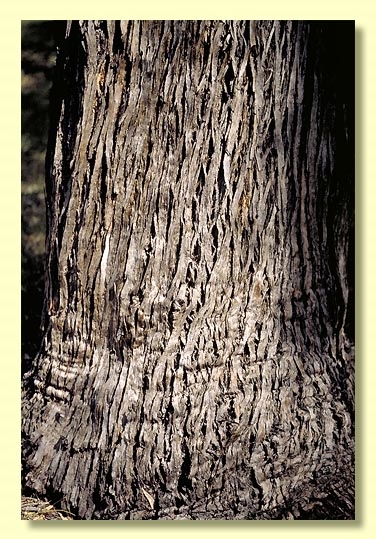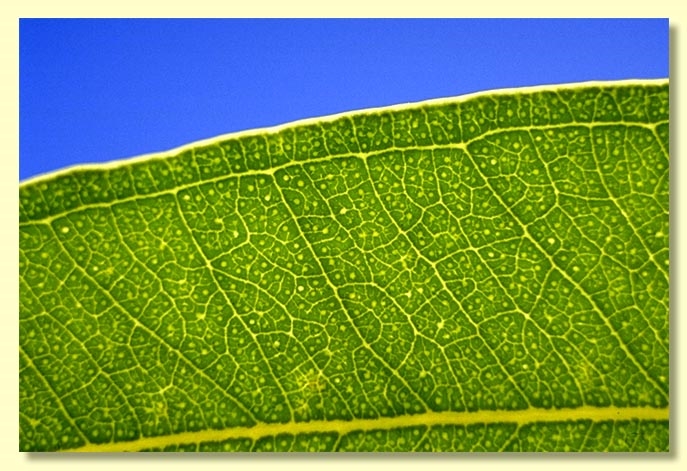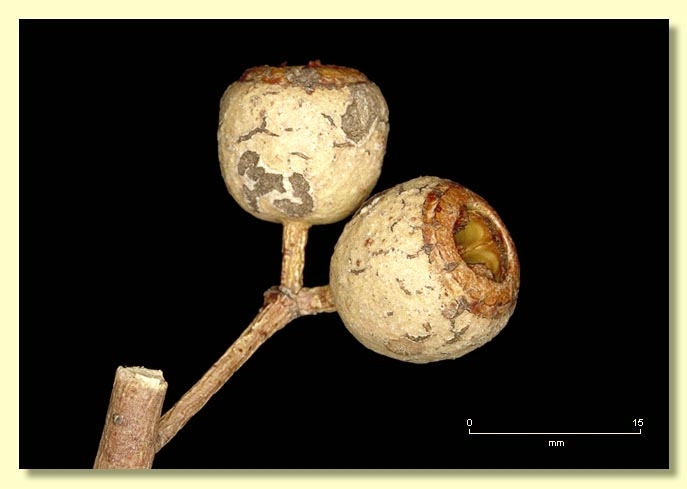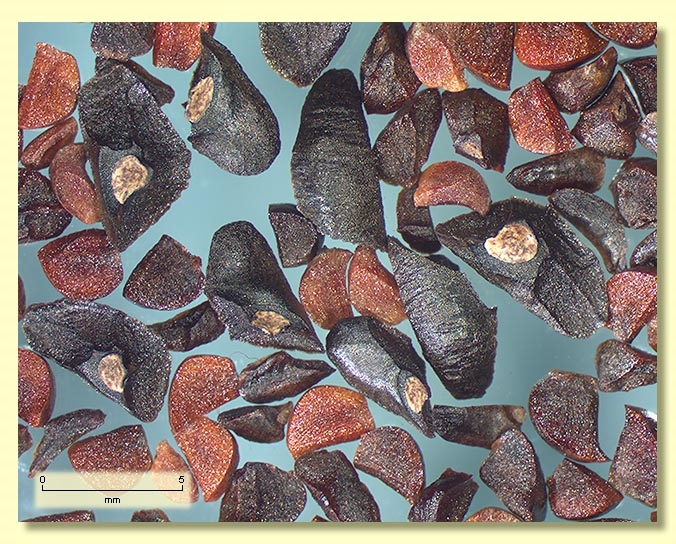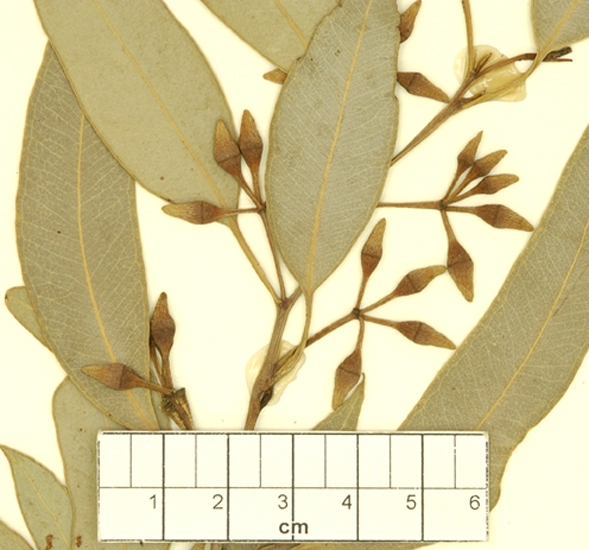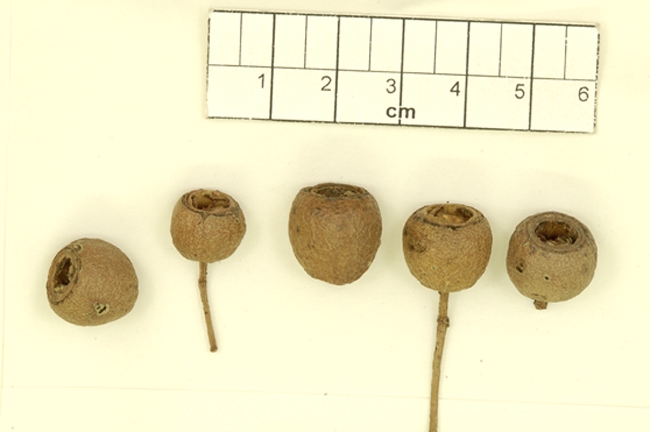Euclid - Online edition
Eucalyptus marginata subsp. thalassica
Classification
Eucalyptus | Eucalyptus | Longistylus | Arboreae | Occidentales
Nomenclature
Description
Trees to 25 m tall. Forming a lignotuber.
Bark rough to 5–10 cm diameter branches, stringy in broad flat strips, grey to brown over rich red-brown.
Branchlets lacking oil glands in the pith.
Juvenile growth (coppice or field seedlings to 50 cm): stems rounded in cross-section; juvenile leaves always petiolate, alternate, ovate to lanceolate to slightly falcate, 6.5–12.5 cm long, 2.5–5.5 cm wide, dull, blue-grey, concolorous until ca 1 m tall then discolorous.
Adult leaves alternate, petioles 0.8–2.3 cm long; blade lanceolate to falcate, 5.5–12.5 cm long, (1)1.5–3(3.5) cm wide, base oblique or tapering to petiole, margin entire, apex often a drip-tip, discolorous, dull, blue-grey to grey above and paler on underside, side-veins greater than 45° to midrib, reticulation moderate, intramarginal vein remote from margin, oil glands round, island.
Inflorescence axillary unbranched, peduncles 0.5–2.7 cm long, buds 7 to 15 per umbel, pedicels 0.5–0.8 cm long. Mature buds elongated ovoid, 0.9–1.3 cm long, 0.3–0.4 cm wide, scar absent, the single operculum bluntly to acutely conical to horn-shaped (length of operculum variable, from ca 1.5 to 2.6 times the hypanthium), stamens mostly erect or only outermost erect with inner stamens inflexed, anthers reniform, versatile, dorsifixed, dehiscing by oblique slits that are confluent apically, style long and straight, stigma tapered, locules 3 or 4, the placentae each with 2 vertical rows of ovules. Flowers creamy white.
Fruit pedicels 0.3–0.8 cm wide, usually barrel-shaped to truncate-globose, 0.9–1.5 cm long, 1–1.5 cm wide, disc level to descending, valves 3 or 4, at rim level.
Seeds blackish brown, 3–6 mm long, obliquely pyramidal, dorsal surface smooth, ventrally ridged, hilum terminal.
Cultivated seedlings (measured at ca node 10): cotyledons reniform with their petioles arising from the developing stem below ground level or at ground level; stems rounded in cross-section; leaves opposite, sessile and amplexicaul for ca 4 nodes then petiolate, base rounded to tapering, alternate by node 6–7, ovate-lanceolate, 7–9.5 cm long, 2.5–3.5 cm wide, dull, mid-green above, discolorous throughout.
Bark rough to 5–10 cm diameter branches, stringy in broad flat strips, grey to brown over rich red-brown.
Branchlets lacking oil glands in the pith.
Juvenile growth (coppice or field seedlings to 50 cm): stems rounded in cross-section; juvenile leaves always petiolate, alternate, ovate to lanceolate to slightly falcate, 6.5–12.5 cm long, 2.5–5.5 cm wide, dull, blue-grey, concolorous until ca 1 m tall then discolorous.
Adult leaves alternate, petioles 0.8–2.3 cm long; blade lanceolate to falcate, 5.5–12.5 cm long, (1)1.5–3(3.5) cm wide, base oblique or tapering to petiole, margin entire, apex often a drip-tip, discolorous, dull, blue-grey to grey above and paler on underside, side-veins greater than 45° to midrib, reticulation moderate, intramarginal vein remote from margin, oil glands round, island.
Inflorescence axillary unbranched, peduncles 0.5–2.7 cm long, buds 7 to 15 per umbel, pedicels 0.5–0.8 cm long. Mature buds elongated ovoid, 0.9–1.3 cm long, 0.3–0.4 cm wide, scar absent, the single operculum bluntly to acutely conical to horn-shaped (length of operculum variable, from ca 1.5 to 2.6 times the hypanthium), stamens mostly erect or only outermost erect with inner stamens inflexed, anthers reniform, versatile, dorsifixed, dehiscing by oblique slits that are confluent apically, style long and straight, stigma tapered, locules 3 or 4, the placentae each with 2 vertical rows of ovules. Flowers creamy white.
Fruit pedicels 0.3–0.8 cm wide, usually barrel-shaped to truncate-globose, 0.9–1.5 cm long, 1–1.5 cm wide, disc level to descending, valves 3 or 4, at rim level.
Seeds blackish brown, 3–6 mm long, obliquely pyramidal, dorsal surface smooth, ventrally ridged, hilum terminal.
Cultivated seedlings (measured at ca node 10): cotyledons reniform with their petioles arising from the developing stem below ground level or at ground level; stems rounded in cross-section; leaves opposite, sessile and amplexicaul for ca 4 nodes then petiolate, base rounded to tapering, alternate by node 6–7, ovate-lanceolate, 7–9.5 cm long, 2.5–3.5 cm wide, dull, mid-green above, discolorous throughout.
Flowering Time
Flowering has been recorded in February and October.
Notes
Eucalyptus marginata is a tall forest tree species, or rarely a mallee, endemic to Western Australia, widespread from the Mt Lesueur area, where it is reduced to a mallee on sands, extending to the east of Albany. It occurs on a wide variety of sites and reaches its greatest stature on the red loams of the wetter south-west in the Warren and Murray River valleys. On the nutritionally poorer laterite soils in the area east of Busselton north to New Norcia E. marginata is abundant but forms forests of lower stature.
Within its natural range E. marginata is distinguished from other rough-barked tree species by the combination of fibrous bark, discolorous adult leaves that are paler on the underside, axillary inflorescences with buds in clusters of sevens to threes, buds with an elongated conical operculum, long style and most stamens erect and all fertile, and early seedling leaves sessile but soon becoming petiolate. E. jacksonii differs in the shorter buds and smaller fruit. E. brevistylis differs in having delicate, rounded buds with a short style and infertile outer stamens. E. staeri differs in having concolorous adult leaves that lack oil glands and much more depauperate habit. E. patens also has concolorous adult leaves, larger juvenile leaves, rough bark that is more corky than fibrous, smaller buds with a rounded-apiculate operculum, irregularly flexed stamens with anthers with non-confluent slits.
Eucalyptus marginata belongs in Eucalyptus subgenus Eucalyptus section Longistyles, characterised by buds with a single operculum (hence no operculum scar), reniform anthers that shed pollen through slits that are confluent apically, ovules arranged in two rows on the placenta, plus the features outlined above. Species in subgenus Eucalyptus fall within two groups depending on how the stamens shed their pollen. One group, including E. jacksonii, E. staeri and E. brevistylis from Western Australia and the majority of species in subgenus Eucalyptus from eastern Australia, shed pollen as does E. marginata. Many other western species shed pollen from oblong anthers with slits that always remain separate.
There are three subspecies:
E. marginata subsp. marginata
The common tree of the Darling Range and further south but has a mallee form in its northernmost occurrence near Mt Lesueur. Subsp. marginata has leaves that are green on the upper face, paler below.
E. marginata subsp. elegantella
Of very restricted occurrence between Perth and Serpentine to the south-east. Subsp. elegantella is characterised by the small, narrow leaves.
E. marginata subsp. thalassica
The common form occuring in the northern Darling Range and north to New Norcia. Subsp. thalassica is characterised by the blue-green to greyish adult leaves and may have a tumble-down habit in the east of its distribution.
Within its natural range E. marginata is distinguished from other rough-barked tree species by the combination of fibrous bark, discolorous adult leaves that are paler on the underside, axillary inflorescences with buds in clusters of sevens to threes, buds with an elongated conical operculum, long style and most stamens erect and all fertile, and early seedling leaves sessile but soon becoming petiolate. E. jacksonii differs in the shorter buds and smaller fruit. E. brevistylis differs in having delicate, rounded buds with a short style and infertile outer stamens. E. staeri differs in having concolorous adult leaves that lack oil glands and much more depauperate habit. E. patens also has concolorous adult leaves, larger juvenile leaves, rough bark that is more corky than fibrous, smaller buds with a rounded-apiculate operculum, irregularly flexed stamens with anthers with non-confluent slits.
Eucalyptus marginata belongs in Eucalyptus subgenus Eucalyptus section Longistyles, characterised by buds with a single operculum (hence no operculum scar), reniform anthers that shed pollen through slits that are confluent apically, ovules arranged in two rows on the placenta, plus the features outlined above. Species in subgenus Eucalyptus fall within two groups depending on how the stamens shed their pollen. One group, including E. jacksonii, E. staeri and E. brevistylis from Western Australia and the majority of species in subgenus Eucalyptus from eastern Australia, shed pollen as does E. marginata. Many other western species shed pollen from oblong anthers with slits that always remain separate.
There are three subspecies:
E. marginata subsp. marginata
The common tree of the Darling Range and further south but has a mallee form in its northernmost occurrence near Mt Lesueur. Subsp. marginata has leaves that are green on the upper face, paler below.
E. marginata subsp. elegantella
Of very restricted occurrence between Perth and Serpentine to the south-east. Subsp. elegantella is characterised by the small, narrow leaves.
E. marginata subsp. thalassica
The common form occuring in the northern Darling Range and north to New Norcia. Subsp. thalassica is characterised by the blue-green to greyish adult leaves and may have a tumble-down habit in the east of its distribution.
Origin of Name
Eucalyptus marginata: Latin marginatus, with a margin, an obscure allusion to the leaf edges which are not unusually conspicuous.
subsp. thalassica: Latin thalassicus, sea-water coloured, blue-green, referring to the leaves and crown.
subsp. thalassica: Latin thalassicus, sea-water coloured, blue-green, referring to the leaves and crown.
Copyright © CANBR 2020, all rights reserved.

Web edition hosted at https://apps.lucidcentral.org/euclid

